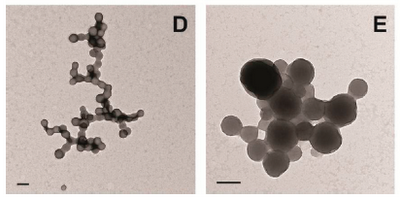

| Visitors Now: | |
| Total Visits: | |
| Total Stories: |

| Story Views | |
| Now: | |
| Last Hour: | |
| Last 24 Hours: | |
| Total: | |
Anticancer drugs form colloidal aggregates and lose activity
Over the last few years, one of the most interesting findings in drug screening and testing at a preclinical level has been the observation that many drugs form colloidal aggregates under standard testing conditions and nonspecifically inhibit target proteins which they otherwise would not affect. This are large aggregates, a hundred nanometers or more in diameter, and they cause proteins to stick and partially unfold, creating the illusion of inhibition. This leads to false positives, especially in high-throughput screening protocols. And these false positives can be absolutely rampant.
What’s striking is the sheer ubiquity of this phenomenon which has been observed with all kinds of drugs under all kinds of conditions; while the initial observation was limited to isolated protein-based assays, the phenomenon has also been seen in simulated gastric fluids and in the presence of many different kinds of proteins like serum albumin which are found inside the body. The colloid spirit seems to emphatically favor a shotgun approach.
Now a team led by the brother-sister duo Brian and Molly Shoichet (UCSF and Toronto) has found something that should give drug testers further pause for thought; they see some bestselling anticancer drugs forming colloids (shown above) in cell-based assays to an extent that actually diminishes their activity, leading not to false positives but to false negatives. They test seven known anticancer drugs in cell assays both under known colloid forming conditions along with conditions that break the colloids up. This is not as easy as it sounds since it involves adding a detergent which would usually be too toxic to cells; fortunately in this case they find the right one. Another interesting finding is the re-evaluation of a popular dye used to study “leaky” cancer blood vessels; unlike the previously proposed mechanism, the current study seems to suggest that the dye too forms large aggregates and nonspecifically inhibits the protein serum albumin.
The testing essentially reveals that the drugs when they form colloids basically show activity that’s so low as to be negligible and equivalent to the controls. That’s a self-(un)proclaimed false negative. Now anybody who deals with error analysis knows that false negatives are fundamentally worse than false positives since by definition they cannot even be detected. The present study raises the pertinent question; how many promising drugs might we be missing because they form aggregates and lower the observed response in cells? And since the colloid forming phenomenon has been shown to be so ubiquitous, could it possibly be influencing the mechanism of action of all kinds of drugs inside the body? And in what ways? It’s a fascinating question, and one of those that continues to make basic research in drug discovery still so interesting.
Image source and credit: ACS
Read more at The Curious Wavefunction
Source:



